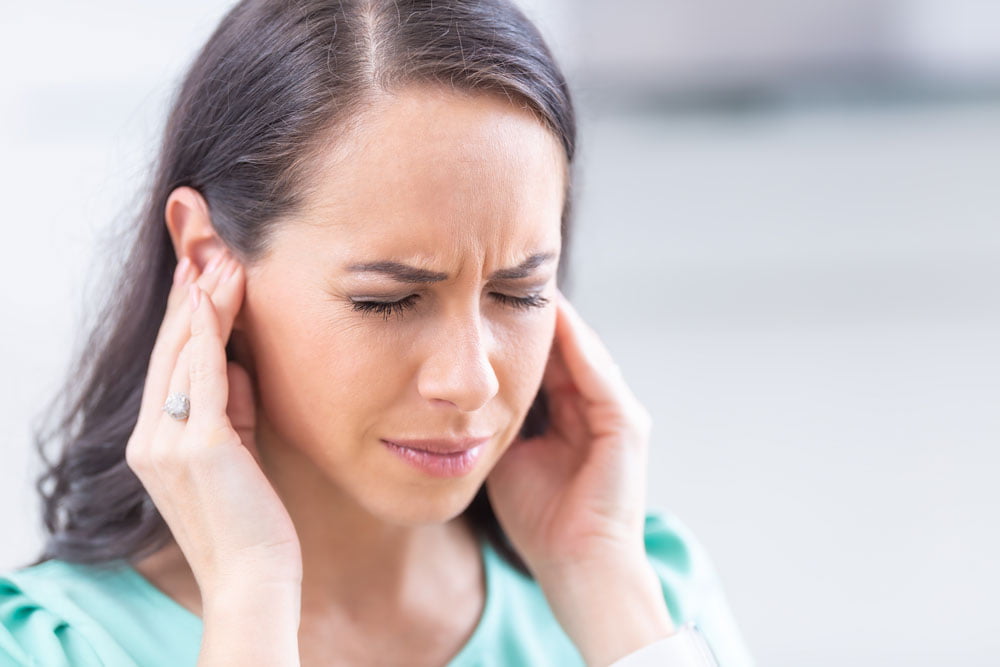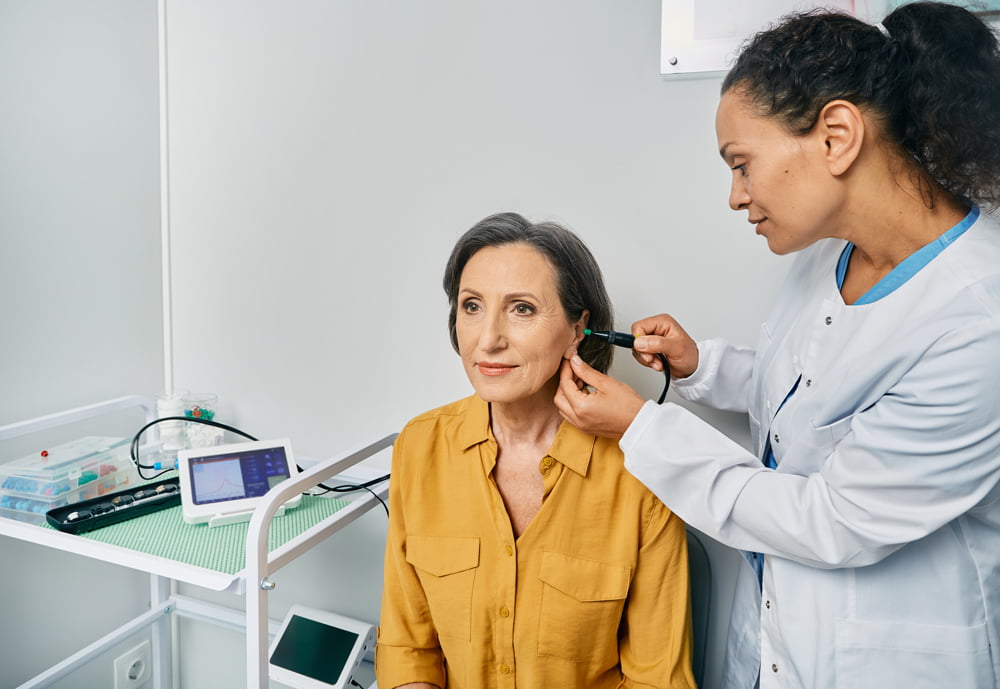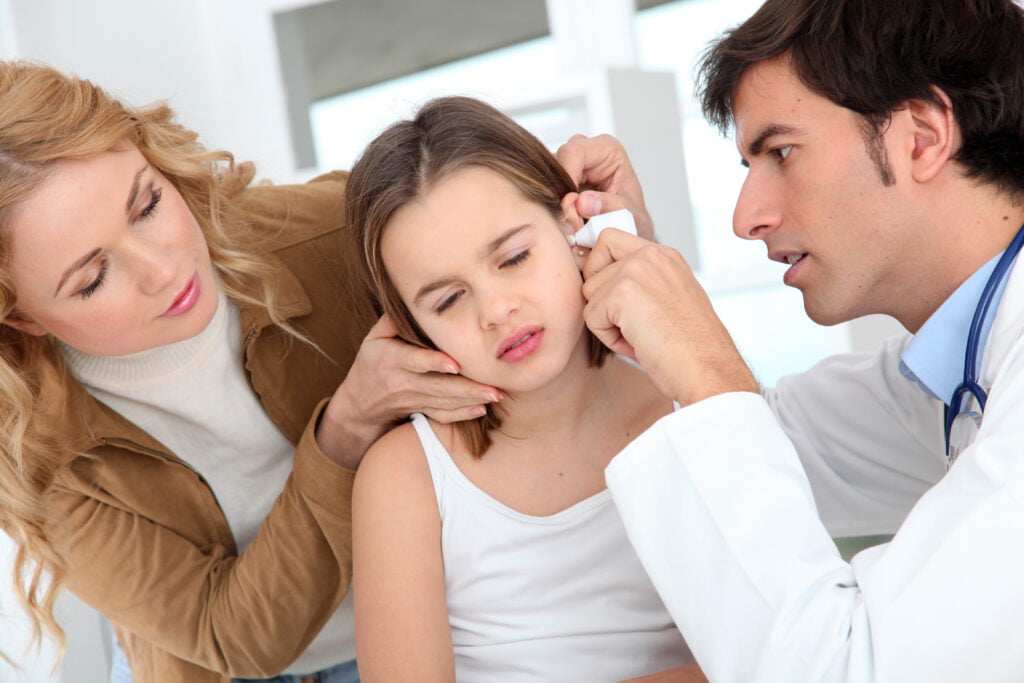Ear infection are a common but often misunderstood ailment that can affect individuals of all ages. In fact, they are one of the most frequently diagnosed illnesses in children, with about 5 out of 6 children experiencing at least one ear infection by their third birthday. However, adults are not immune to these painful and sometimes debilitating conditions, accounting for a significant number of doctors’ visits each year.
Whether you’re dealing with this yourself, caring for a loved one, or simply seeking to expand your knowledge, read on to gain valuable insights and practical advice to help you navigate ear health effectively!
In This Article:
-
- Types of Ear Infections- Types of Ear Infections
-
- Causes of Ear Infections- Causes of Ear Infections
-
- Symptoms of Ear Infections- Symptoms of Ear Infections
-
- Diagnosing Ear Infections- Diagnosing Ear Infections
-
- Treatment Options for Ear Infections- Treatment Options for Ear Infections
-
- Complications of Untreated Ear Conditions- Complications of Untreated Ear Conditions
-
-Tips for Preventing Ear Infections-Tips for Preventing Ear Infections
Types of Otitis Ear Infections
These are a common and often painful condition that occurs when a part of your ear becomes affected by bacteria of viruses. These infections can affect anyone but are particularly common in children.
Outer Ear Infection (Otitis Externa)
An outer ear infection, also known as “swimmer’s ear,” affects the ear canal, which runs from the outer ear to the eardrum. This type of infection often occurs when water remains in the ear canal after swimming, providing a moist environment for bacteria to thrive.
Middle Ear Infection (Otitis Media)
These conditions are particularly common in children and occur in the space behind the eardrum. They often follow a respiratory infection, such as a cold, which can spread to the middle ear. They can cause significant discomfort and may affect hearing temporarily.
Inner Ear Infection (Otitis Interna or Labyrinthitis)
Inner ear infections are less common but can be more severe. They impact the inner ear, which is crucial for both hearing and balance. Causes include viral infections, bacterial infections, and sometimes autoimmune conditions.
Causes of Ear Infections
These conditions can result from various factors, including bacterial and viral infections, environmental influences, and anatomical issues. Understanding these causes can help in both prevention and treatment.
Bacterial and Viral Infections
The most common cause for this type of infection is bacterial or viral. These infections often follow upper respiratory infections such as colds or flu. Bacteria like Streptococcus pneumoniae and Haemophilus influenzae are frequently implicated in middle ear infections. Viruses, including those that cause colds, can also lead to ear conditions by causing inflammation and fluid build-up in the ear.
Environmental Factors
Certain environmental factors can increase the risk of developing these conditions. For example, frequent swimming can lead to swimmer’s ear, a type of outer ear infection, due to the presence of water in the ear canal that fosters bacterial growth. Allergies are another environmental factor that can cause inflammation and congestion in the nasal passages and Eustachian tubes. In turn, this contributes to the development of middle ear infections. Additionally, exposure to tobacco smoke or other pollutants can irritate the ear and increase the likelihood of infections.
Anatomical Factors
Anatomical factors also play a significant role in the development of an ear infection. One of the most important anatomical issues is Eustachian tube dysfunction. The Eustachian tube connects the middle ear to the back of the throat and helps to equalise pressure and drain fluids. When the Eustachian tube is blocked or doesn’t function properly, fluid can accumulate in the middle ear, creating an environment where bacteria and viruses can grow. Children are particularly susceptible to Eustachian tube dysfunction because their tubes are shorter, more horizontal, and more easily blocked.
Can Hearing Aids Cause Ear Infections?
Additionally, the use of hearing aids can sometimes contribute to ear conditions. Hearing aids can create a warm, moist environment in the ear canal, which can encourage the growth of bacteria and fungi. Proper cleaning and maintenance of hearing aids are crucial to prevent this in hearing aid users.
Can Heat Cause an Ear Infection?
Heat itself does not directly cause ear infections, but it can create conditions that may lead to infections. For instance, during hot weather, increased sweating and moisture can occur in the ear canal, especially for those who use hearing aids or earplugs. This warm, moist environment can promote the growth of bacteria and fungi, potentially leading to an outer ear infection. It’s important to keep ears dry and clean, particularly in hot and humid conditions, to reduce this risk.
Symptoms of Ear Infections
Ear infections can manifest through a variety of symptoms that may vary between adults and children. Recognising these symptoms early can help in seeking timely treatment and preventing complications.
Ear Infections in Adults:
- Ear Pain: A persistent or sharp pain in the ear is a common symptom.
- Hearing Loss: Temporary hearing loss or a feeling of fullness in the ear can indicate fluid build-up.
- Drainage: A clear, yellow, or bloody fluid may drain from the ear.
- Tinnitus: Ringing or buzzing in the ear.
- Dizziness: A sensation of spinning or loss of balance.
Ear Infections in Children:
- Irritability: Infants and young children may become more irritable than usual.
- Crying and Tugging: Frequent crying and tugging or pulling at the ear.
- Fever: Elevated body temperature often accompanies these condition in children.
- Trouble Sleeping: Discomfort may cause difficulty in sleeping or lying down.
- Poor Appetite: A reduction in appetite due to pain and discomfort during swallowing.
- Balance Issues: Difficulty maintaining balance, which is more noticeable in toddlers.
Signs to Look Out for Indicating a Serious Infection
While many ear infections resolve on their own, certain symptoms may indicate a more serious infection that requires prompt medical attention:
- Severe Pain: Intense pain that doesn’t subside with over-the-counter pain medications.
- High Fever: A fever of 102°F (38.9°C) or higher, especially in young children.
- Persistent Symptoms: Symptoms that last more than a few days without improvement.
- Hearing Loss: Sudden or severe hearing loss in one or both ears.
- Swelling Behind the Ear: Swelling, redness, or tenderness behind the ear could indicate mastoiditis, a serious infection of the mastoid bone.
- Persistent Drainage: Ongoing fluid drainage from the ear, particularly if it’s thick or bloody.
- Severe Dizziness or Balance Issues: Intense vertigo or balance problems can indicate a more serious inner ear issue.
Recognising these symptoms and understanding when to seek professional help can prevent complications and ensure proper treatment.

Diagnosing Ear Infections
Accurate diagnosis is crucial to ensure effective treatment and prevent complications.
When to Seek Professional Health
While some ear infections may resolve on their own, it’s important to know when to seek professional medical advice:
- Persistent Symptoms: If symptoms such as ear pain, hearing loss, or discharge persist for more than a few days, it’s time to see a healthcare professional.
- Severe Pain: Intense pain that doesn’t respond to over-the-counter pain relievers should be evaluated by a professional.
- High Fever: A fever higher than 102°F (39°C), especially in children, warrants a visit to the doctor.
- Discharge from the Ear: Pus or blood coming from the ear is a sign of a potentially serious infection that needs medical attention.
- Hearing Loss: Sudden or significant hearing loss should be promptly assessed to prevent long-term damage.
- Recurring Infections: Frequent ear infections may indicate an underlying issue that requires professional evaluation and treatment.
Common Diagnostic Methods
Healthcare professionals use several methods to diagnose ear infections accurately:
Otoscopy: An otoscope is a handheld device with a light and magnifying lens used to examine the ear canal and eardrum. Doctors look for signs of infection, such as redness, swelling, fluid behind the eardrum, or a perforation.
Tympanometry: This test measures eardrum movement in response to air pressure changes. It helps detect fluid in the middle ear, eustachian tube dysfunction, or a perforated eardrum.
Audiometry: If hearing loss is a symptom, an audiologist may conduct a hearing test to assess the extent of impairment. This involves listening to sounds at different pitches and volumes to determine hearing thresholds.
Acoustic Reflectometry: This test uses sound waves to measure how much sound is reflected back from the eardrum. It helps detect fluid in the middle ear by analyzing sound reflections.
Lab Tests: If a specific bacteria or virus is suspected, a sample of ear discharge may be taken and sent to a lab for analysis. This helps identify the exact pathogen and tailor the treatment.
Imaging Tests: For severe or complicated cases, imaging tests such as CT scans or MRIs may be used to get a detailed view of the ear structures. This is particularly useful for diagnosing inner ear infections or complications like mastoiditis.
By understanding the symptoms and diagnostic methods for ear infections, patients and caregivers can ensure timely and accurate treatment. If you suspect an ear conditions, seek professional medical advice promptly.
Treatment Options for Ear Infections
Ear infections can be irritating and bothersome. However, understanding the treatment options available can help you manage symptoms effectively and prevent complications. Here’s an overview of the various approaches to treating them:
Home Remedies and Over-the-Counter Treatments
For mild ear infections or to manage symptoms before seeing a healthcare professional, several home remedies and over-the-counter treatments can be effective:
- Pain Relievers: Over-the-counter pain medications such as ibuprofen or paracetamol can help reduce ear pain and fever. Always follow the dosing instructions on the label.
- Warm Compresses: Applying a warm compress to the affected ear can help alleviate pain. Use a warm, moist washcloth and hold it against the ear for 10-15 minutes.
- Ear Drops: Over-the-counter ear drops designed to reduce pain can be used, but it’s important to consult with a healthcare provider before using them, especially if you suspect a perforated eardrum.
- Rest: Ensuring you get plenty of rest can help your body fight the infection more effectively.
Prescription Medications
If an ear infection is more severe or doesn’t improve with home remedies, a healthcare professional may prescribe medications:
- Antibiotics: For bacterial ear infections, antibiotics such as amoxicillin are commonly prescribed. It’s crucial to complete the full course of antibiotics, even if symptoms improve, to ensure the infection is fully eradicated and to prevent antibiotic resistance.
- Antiviral Drugs: If a viral infection is suspected, antiviral medications may be prescribed, although they are less common than antibiotics for ear condition.
- Topical Antibiotics: For outer ear infections (otitis externa or swimmer’s ear), antibiotic ear drops may be prescribed to directly target the infection.
- Steroid Ear Drops: In some cases, steroid ear drops are used to reduce inflammation and swelling in the ear canal.
Surgical Options for Chronic or Severe Cases
For chronic or severe ear infections that do not respond to medical treatments, surgical options may be considered:
- Myringotomy: This procedure involves creating a small incision in the eardrum to drain fluid from the middle ear. It can relieve pressure and reduce pain.
- Ear Tubes: Inserting small tubes through the eardrum can help ventilate the middle ear and prevent fluid accumulation. This is commonly done for children with recurrent ear infections.
- Adenoidectomy: If enlarged adenoids are contributing to chronic ear infections, surgical removal of the adenoids may be recommended.
- Tympanoplasty: In cases where a perforated eardrum doesn’t heal on its own, a surgical repair called tympanoplasty may be performed to close the hole in the eardrum and restore normal hearing function.
By understanding the various treatment options for ear infections, you can take the necessary steps to manage symptoms effectively and seek professional help when needed.

Complications of Untreated Ear Conditions
Leaving an ear infection untreated can lead to several serious complications. Understanding the potential risks and long-term effects on hearing and overall ear health is essential for encouraging prompt medical attention.
Potential Risks of Leaving an Ear Infection Untreated
- Spread of Infection: An infection of the ear can spread to nearby tissues. For example, a middle ear infection can extend to the mastoid bone, leading to mastoiditis, a serious condition that can damage the bone and surrounding tissues.
- Chronic Ear Infections: Acute infections that are not properly treated can become chronic. Chronic ear infections can cause persistent pain, drainage, and hearing loss.
- Eardrum Rupture: Severe or untreated infections can cause a buildup of fluid and pressure, leading to a rupture or perforation of the eardrum. While eardrum perforations often heal on their own, repeated ruptures can cause scarring and long-term hearing issues.
- Hearing Loss: Persistent fluid and infection in the middle ear can lead to conductive hearing loss. In some cases, untreated infections can damage the structures of the inner ear, resulting in permanent sensorineural hearing loss.
Long-Term Effects on Hearing and Ear Health
- Balance Problems: The inner ear is crucial for maintaining balance. Infections that spread to the inner ear (labyrinthitis) can cause dizziness, vertigo, and balance issues. These symptoms can be persistent and significantly impact daily life.
- Speech and Developmental Delays in Children: Chronic ear infections in children can lead to temporary or permanent hearing loss, which in turn can cause speech and language development delays. Early and effective treatment is vital to avoid these developmental setbacks.
- Formation of Cholesteatoma: A cholesteatoma is an abnormal skin growth that can develop in the middle ear as a result of repeated infections. This growth can erode bones and damage the delicate structures of the ear, leading to hearing loss, dizziness, and facial muscle paralysis.
- Facial Nerve Paralysis: Severe infections can affect the facial nerve that runs through the ear. This can lead to weakness or paralysis of the muscles on one side of the face, affecting facial expressions and eye movements.
- Meningitis: In rare cases, an untreated ear infection can lead to the development of bacterial meningitis, a life-threatening infection of the membranes covering the brain and spinal cord. Symptoms include severe headache, fever, neck stiffness, and sensitivity to light.
Importance of Prompt Treatment
Given the potential complications, it is crucial to seek medical attention if you suspect an ear infection, especially if symptoms persist or worsen. Early intervention can prevent these serious outcomes and protect long-term hearing and ear health. If you or your child experience symptoms of an ear infection, contact a healthcare professional promptly for evaluation and treatment.
Tips for Preventing It
Infections can be quite painful and disruptive, but the good news is that there are several effective ways to prevent them. Implementing these preventive measures can help reduce the risk of developing ear infections for both adults and children.
- Avoid Exposure to Tobacco Smoke: Second-hand smoke can irritate the Eustachian tubes, increasing the risk of ear infections, particularly in children. Keep your living environment smoke-free to promote better ear health.
- Manage Allergies: Allergies can cause inflammation and fluid buildup in the ears. Managing allergies through medications or avoiding allergens can help reduce the risk of infections.
- Stay Hydrated: Drinking plenty of fluids helps keep mucus thin, reducing the likelihood of blockages that can lead to infections.
- Practice Good Hand Hygiene: Regular hand washing helps prevent the spread of viruses and bacteria that can cause ear infections. Encourage children to wash their hands frequently, especially during cold and flu season.
- Avoid Inserting Objects into the Ear: Refrain from using cotton swabs, hairpins, or other objects to clean the ear canal. These can push earwax deeper into the ear, causing blockages and increasing the risk of infection.
Conclusion
Ear infections can not only be a serious source of discomfort but can also seriously affect your overall health if left untreated. Understanding the types, causes, symptoms, and prevention strategies can help you manage and mitigate these issues effectively.
If you suspect that you or your child might have an ear infection, it’s crucial to seek professional help promptly. At Hear4U, our experienced audiologists offer comprehensive ear care services, including swab tests to diagnose and treat ear infections accurately. By identifying the exact type of infection, we can refer that to your GP for you to receive the most effective antibiotic, reducing the risk of recurrent infections and ensuring a quicker recovery.
Don’t let an ear infection disrupt your life. Click the link below to book an appointment with Hear4U and get the precise treatment you need to resolve the infection swiftly and effectively.






